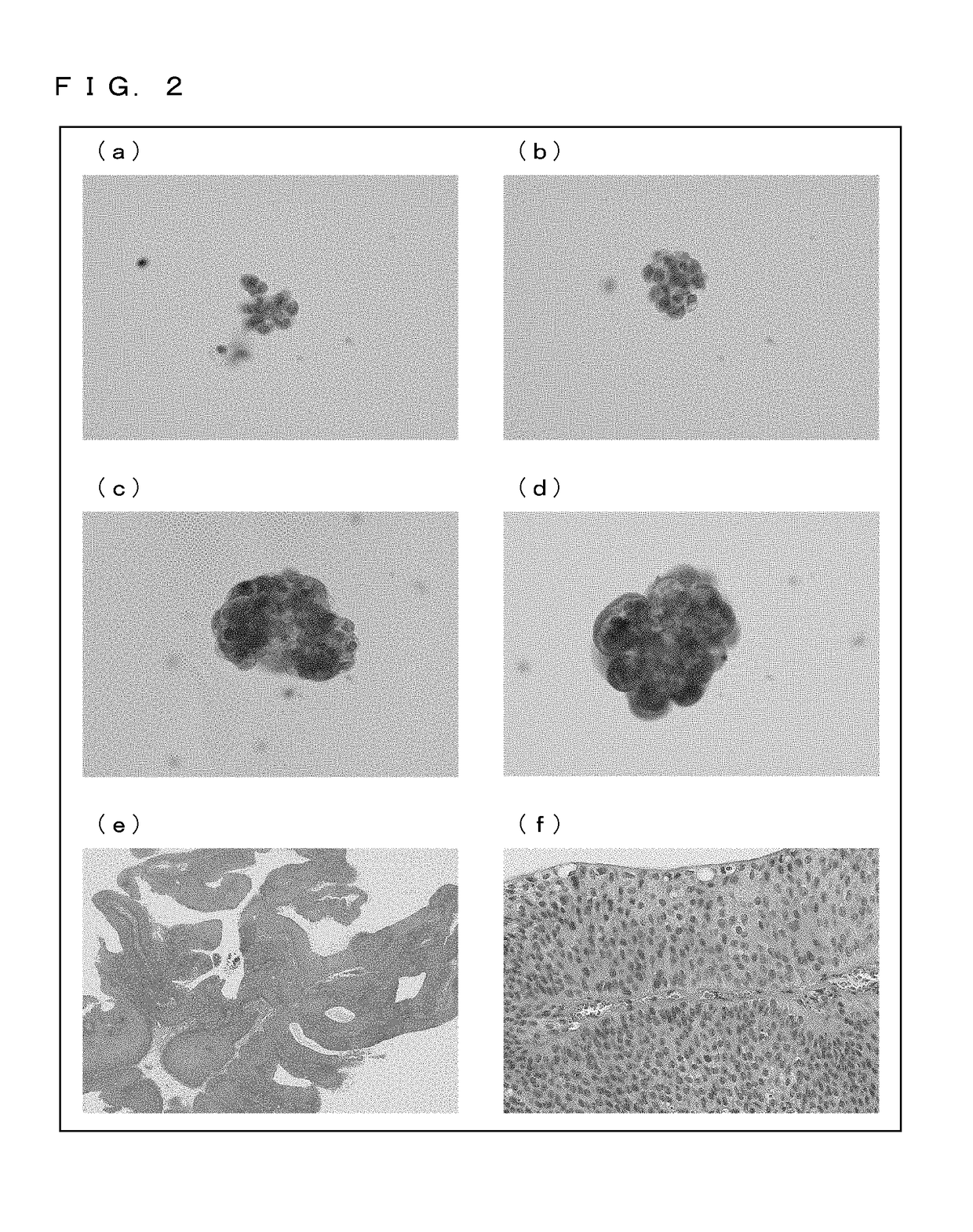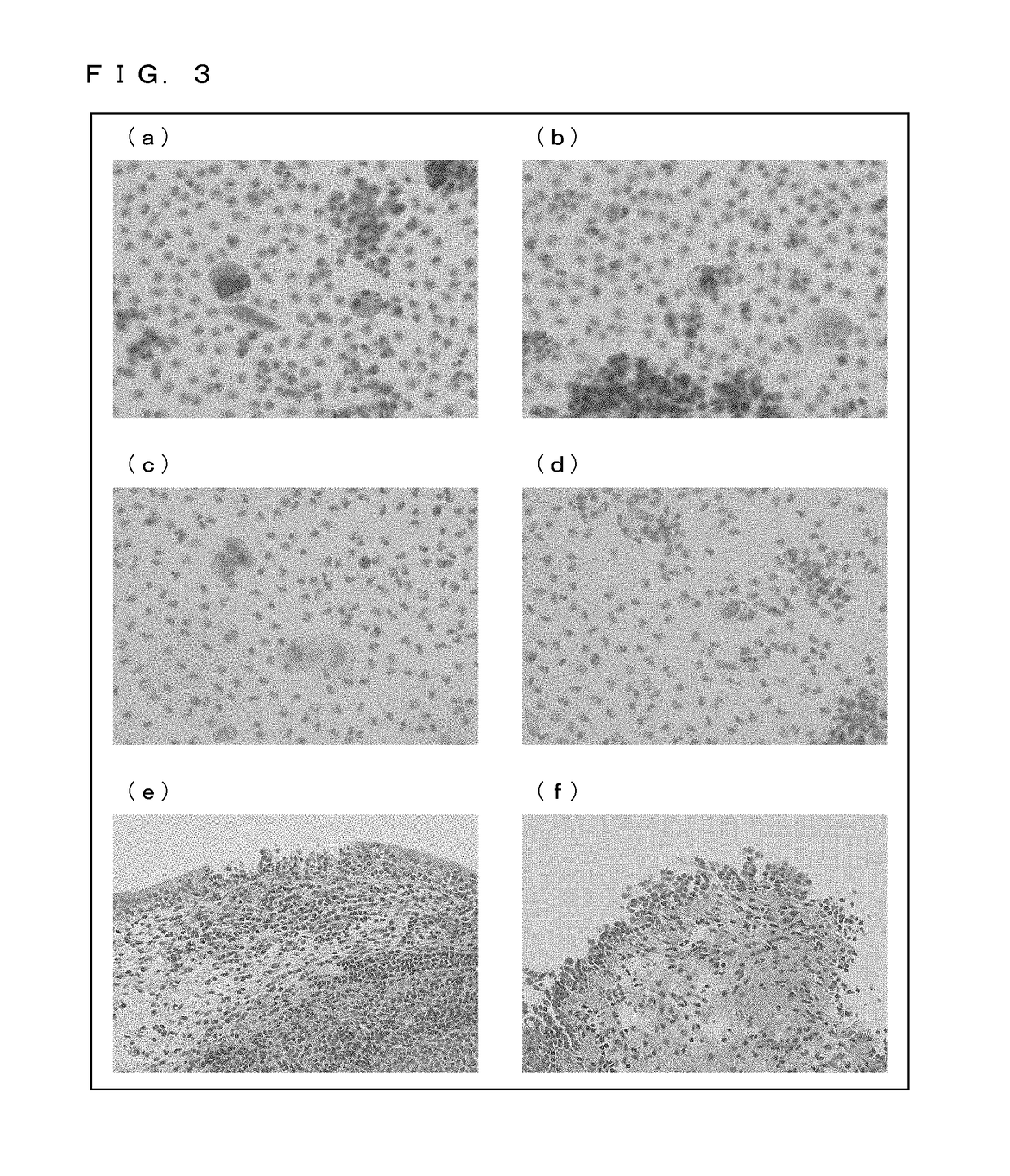Cancer marker and utilization thereof
a cancer marker and cancer technology, applied in the field of cancer markers, can solve the problems of difficult to distinguish between calculus, difficult to detect non-invasive tumors, and difficult to determine the diseased tissue, and achieve the effects of simple diagnosis of urothelial cancer, high diagnostic accuracy, and high specificity
- Summary
- Abstract
- Description
- Claims
- Application Information
AI Technical Summary
Benefits of technology
Problems solved by technology
Method used
Image
Examples
example 1
[Example 1] Immunohistological Staining and Immunocytological Staining with Use of a Ubiquilin 2 Specific Antibody
[0183](1) Experimental Methodology
[0184]
[0185]The ubiquilin 1 specific antibody, the ubiquilin 2 specific antibody, and the ubiquilin 2 specific antibody used were those purchased from Santa Cruz, Inc. Each of the antibodies was 500-fold diluted for use in experiment.
[0186]
[0187]A patient specimen (i.e. a surgically-resected tissue sample) was formalin-fixed, and was then embedded in paraffin. A section was prepared, deparaffinized, rehydrated, and brought into reaction with a primary antibody (ubiquilin 2 specific antibody) (4° C., 18 hours). Then, after a peroxidase-labeled secondary antibody (Nichirei Corporation) was applied and an enzyme-specific substrate was added, the specimen wan stained with a coloring reagent.
[0188]
[0189]Stained samples were prepared with urine specimens collected from patients (preparation of liquefied cytological specimens). Each urine speci...
example 2
[Example 2] Examination 1 of the Effects of Suppression of Ubiquilin 2 Gene Expression
[0223](1) Methodology
[0224]Control RNA (QIAGEN) or ubiquilin 2 siRNA was introduced into human urothelial cancer cell strain KU7 (donated by the School of Urology at the Department of Medicine in Keio University). The ubiquilin 2 siRNA used was siRNA synthesized with 5′-TCCCATAAAGAGACCCTAATA-3′ (SEQ ID NO. 3) of the ubiquilin 2 gene as a Target sequence. The introduction of each RNA was performed by a Lipofection technique with a Lipofectamine™ RNAimax (Life Technologies Japan Ltd.).
[0225]After 72 hours of culture of the cells transfected with the RNA, TUNEL positive cells (i.e. cells having undergone apoptosis) were detected under a fluorescence microscope by the TUNEL (Terminal deoxynucleotidyl transferase dUTP nick end labeling) technique, and the percentage of the TUNEL positive cells to the total number of cells was calculated.
[0226](2) Results
[0227](a) of FIG. 15 shows a result of DAPI staini...
example 3
[Example 3] Examination 2 of the Effects of Suppression of Ubiquilin 2 Gene Expression
[0231](1) Methodology
[0232]To a culture solution prepared by culturing, for 24 hours, cells transfected with RNA in the same manner as in Example 2, thapsigargin (Sigma Corporation), which is an endoplasmic reticulum stress agent, was added so that predetermined concentrations (0.1 μM, 0.5 μM, 1 μM, and 2.5 μM) were achieved.
[0233]Seventy-two hours after the addition of thapsigargin, a cell survival assay (MTS assay: with use of a kit from Promega KK) was performed to obtain the number of cells that survived, and the ratio (cell survival rate) of the number of cells that survived in the presence of thapsigargin to the number of cells that survived in the absence of thapsigargin was calculated.
[0234](2) Results
[0235]FIG. 16 shows cell survival rates as observed 72 hours after the addition of thapsigargin. In a case where the ubiquilin 2 gene is not disrupted (knocked down), thapsigargin hardly exhib...
PUM
| Property | Measurement | Unit |
|---|---|---|
| temperature | aaaaa | aaaaa |
| temperature | aaaaa | aaaaa |
| concentration | aaaaa | aaaaa |
Abstract
Description
Claims
Application Information
 Login to View More
Login to View More - R&D
- Intellectual Property
- Life Sciences
- Materials
- Tech Scout
- Unparalleled Data Quality
- Higher Quality Content
- 60% Fewer Hallucinations
Browse by: Latest US Patents, China's latest patents, Technical Efficacy Thesaurus, Application Domain, Technology Topic, Popular Technical Reports.
© 2025 PatSnap. All rights reserved.Legal|Privacy policy|Modern Slavery Act Transparency Statement|Sitemap|About US| Contact US: help@patsnap.com



